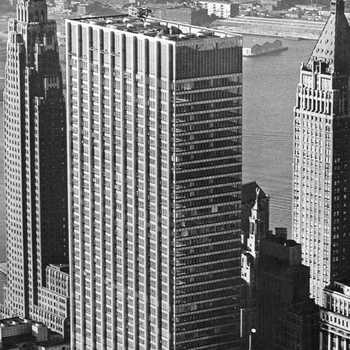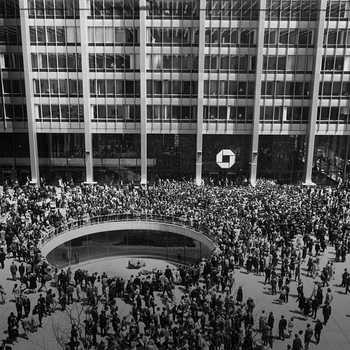On May 18, 1961, Chase Manhattan Bank officially opened its 60-story, state-of-the-art tower in the Wall Street area. The building itself housed the world’s largest bank vault and the largest banking operation ever assembled under one roof — 38 floors of Chase Manhattan offices. To give the press who were invited to the unveiling a view from all angles, Chase President David Rockefeller took them for a helicopter ride around the tip of Manhattan and described through a hand-held microphone the innovation of the building as well as other projects slated as part of the master plan to revitalize the financial district.
The new bank building, officially known as 1 Chase Manhattan Plaza (now known as 28 Liberty Street), was a state-of-the-art skyscraper, representing both architectural and technological innovation for the time. Standing at 813 feet tall, it was the 6th tallest building in the world at the time of its completion and dominated the lower Manhattan skyline.
Standing at 813 feet tall, it was the 6th tallest building in the world
The building cost approximately $120,000,000 and covered two and a half acres of prime real estate, purchased for $7,000,000 an acre.
The building was designed by the renowned architect Gordon Bunshaft of the prestigious architectural firm Skidmore, Owings & Merrill (SOM). It was notable for its sleek and modernist design. The skyscraper featured a striking, aluminum and glass facade and was constructed using the latest building techniques of the era, including a steel-frame structure that allowed for large, open interior spaces. The tower was the first modernist — International Style building in the area and one of the first skyscrapers to be built in the Wall Street area since the Great Depression.
The core of the building, including stairways, elevators, and utilities, was designed to be rigid to absorb the impact of wind and provide stability, an essential feature for tall buildings.
The building included state-of-the-art electrical and mechanical systems consistent with the design standards of the time. This included advanced, high-speed elevators, climate control systems with central air conditioning, and a communications infrastructure to support banking operations. Automated systems for tasks like check sorting and other banking operations were installed, reflecting the growing trend toward automated technology in the financial industry.


The Secret Moving Day Operation
What Rockefeller did not share with the news media was how they transported more than $32 billion of stocks and bonds to the new vault.
The transfer of the securities was made during regular banking hours through the crowded streets of the financial district by Pinkerton armed guards and New York Security Department guards, all dressed in plain clothes. While it may seem impossible to make a move of this magnitude down a crowded street without attracting attention, the success of the exceptionally detailed plan hinged on the inconspicuous dress and conduct.
…unmarked trucks accompanied by unmarked cars and in mobile wooden trunks pushed through the financial district streets.
The securities were transferred — a maximum of $50 million at a time — in unmarked trucks accompanied by unmarked cars and in mobile wooden trunks pushed through the financial district streets. Although mobile trunks were a common sight in the Wall Street area, they were deliberately constructed to be as big, bulky, and heavy as possible so no one could pick them up and run. In all, some 640 wooden trunks were used. The transfer was meticulously and successfully executed — all without public knowledge.
Sources:
"Chase Bank Opens 64-Story Tower," New York Times, 18 May 1961, p. 24.
"One Chase Plaza." SOM, 23 Mar. 2016, www.som.com/news/one-chase-manhattan-plaza-redefining-downtown-and-the-modern-skyscraper/. Accessed 21 Dec. 2023.
"Chase Manhattan Securities Move." The Pinkerton Eye, Pinkerton Archives. Summer 1961.
Library of Congress. Photographer, Hiller, Herman, photographer, 6 May 1964. [Chase Manhattan Bank, New York City, plaza with large crowd] - digital file from original photograph | Library of Congress (loc.gov)
